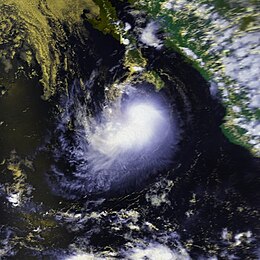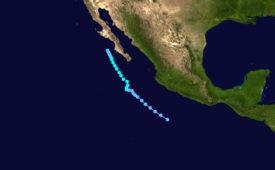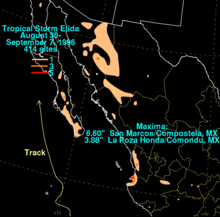User:IPhonehurricane95/sandbox/Elida
| Tropical storm (SSHWS/NWS) | |
 Tropical Storm Elida off the Baja California Peninsula | |
| Formed | August 30, 1996 |
|---|---|
| Dissipated | September 6, 1996 |
| Highest winds | 1-minute sustained: 65 mph (100 km/h) |
| Lowest pressure | 994 mbar (hPa); 29.35 inHg |
| Fatalities | 6 |
| Damage | Minimal |
| Areas affected | Mexico, Baja California |
| Part of the 1996 Pacific hurricane season | |
Tropical Storm Elida was a strong tropical storm that killed 6 people offshore Mexico and affected over 1,000 others. The ninth tropical cyclone of the below-average 1996 Pacific hurricane season, Elida's orgins was a tropical wave that organized into Tropical Depression Eight-E on August 30. The cyclone paralleled the coast of Mexico and also gradually decelerated. Despite some wind shear, Eight-E strengthened into a tropical storm on September 2 and was named Elida. On September 3 and 4, Elida came close to the southern tip of the Baja California Peninsula at its peak intensity of 994 mbar (29.4 inHg) and winds of 65 mph (100 km/h). The cyclone then drifted into cooler waters, was devoid of deep convection on September 5, and dissipated the next day.[1]
The storm was forecast slightly better than the long term averages for the eastern North Pacific.[1] Elida posed enough of a threat to the Baja California Peninsula to require a tropical storm warning for the Baja California Peninsula south of Cabo San Lázaro on September 3. The warning was lifted on September 5 after the threat ended.[1] Moderate to heavy rains fell in association with the tropical cyclone across southwest Mexico and the Baja California peninsula, with the maxima falling at San Marcos/Compostela in southwest mainland Mexico, which measured 6.60 in (168 mm), and a maximum for Baja California of 3.88 in (99 mm) at La Poza Honda/Comondu.[1] While passing offshore, the tropical storm killed six people and affected 1,200 others,[2] but the damages were minimal.
Meteorological history
[edit]
Tropical storm (39–73 mph, 63–118 km/h)
Category 1 (74–95 mph, 119–153 km/h)
Category 2 (96–110 mph, 154–177 km/h)
Category 3 (111–129 mph, 178–208 km/h)
Category 4 (130–156 mph, 209–251 km/h)
Category 5 (≥157 mph, ≥252 km/h)
Unknown
A tropical wave moved across the tropical Atlantic during mid to late August, developing a small area of thunderstorms each day. After it moved into the Pacific Ocean, thunderstorm activity became more concentrated on August 30th to the south of Mexico.
Becoming a tropical depression, the system initially moved west-northwest towards the 110th meridian. Light northeasterly vertical wind shear kept development slow, with the system named Tropical Storm Elida on September 2nd. Elida posed enough of a threat to the Baja California Peninsula to require a tropical storm warning for the Baja California Peninsula south of Cabo San Lázaro on September 3.
An upper low moved to the north of the system, slowing its forward movement and shifting its track more northerly in the direction of Baja California. After paralleling the southern tip of the peninsula, a combination of vertical wind shear and reduced sea surface temperatures weakened the system to dissipation by the time it passed Point Eugenia on September 7th.
During Elida's passage, the storm killed 6 people offshore and affected more than 1,200 people. Moderate to heavy rains fell in association with the tropical cyclone across southwest Mexico and the Baja California Peninsula.
Impact
[edit]
References
[edit]- ^ a b c d Edward Rappaport (1996-07-11). "Tropical Storm Elida Preliminary Report". National Hurricane Center. Retrieved 2007-02-23. Cite error: The named reference "Elida" was defined multiple times with different content (see the help page).
- ^ "Hurricane Marty". Centre for Research on the Epidemiology of Disasters. Retrieved 2012-1-16.
{{cite web}}: Check date values in:|accessdate=(help)
